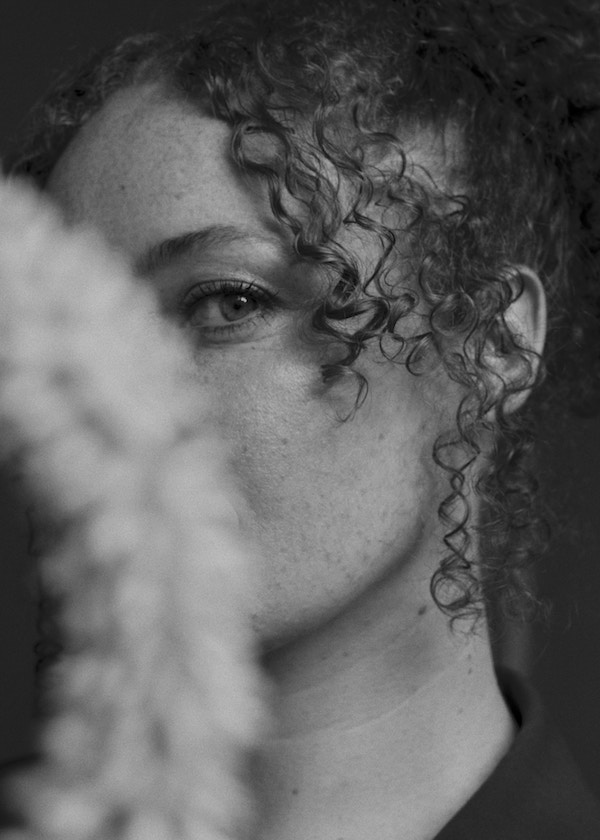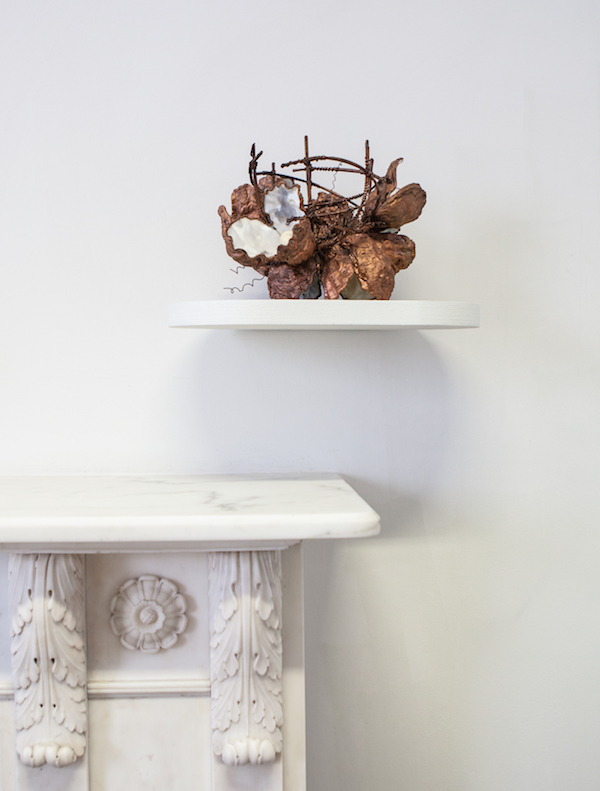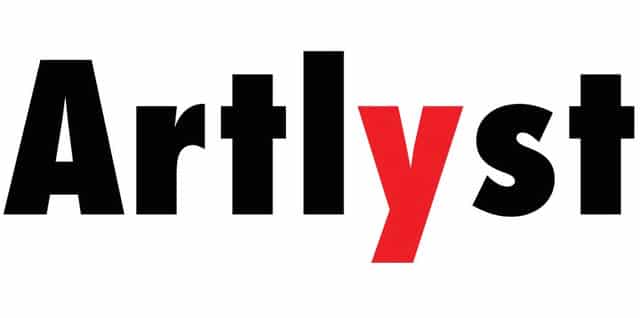‘A Moveable Feast’ is a presentation of small sculpture and digital prints by the artist Emma Witter. The exhibition takes place on the first floor of a handsome listed Georgian townhouse on The Portman Estate in Marylebone, London, open by appointment until the 3rd of January. Elegant cornices frame the walls, painted a soft egg shell teal; giant shafts of light spill across the room from double sash windows onto a Victorian iron cast fireplace. Every aspect of the space is welcoming; like hearth and home, there is a sense of intimacy. “I want you to walk in and feel immediately relieved that it’s quiet and peaceful inside. I’ve made works with that in mind, small and harmless.”
“Nature is a haunted house .. but Art is a house that tries to be haunted.” – Emily Dickinson
Emma considers who might have originally occupied the rooms of this Victorian mansion block. Whilst female entrepreneurs were rare before their social and political emancipation, at least 30% of shop owners in the fashion and homeware sector were women. “I often feel like I come from another era; not making work that is current – more aligned with an older, artisanal way. Being in this space I started thinking about artisans from the Victorian era, who often lived above their own shops. Fully integrated in the process of making, showing and selling, they also formed an integral part of the community to which they belonged.”

Emma Witter Portman Estate Marylebone, London Portrait by Gaetan Bernede
Only several minutes walk from her studio/ home, Emma moves seamlessly between the spaces; gathering, unpacking, sorting, storing – preparing the ground for new work. Found chicken bones, pulled pigs teeth, discarded clams, oyster and egg shells are unpacked and rearranged. Some pieces fit together, others don’t. Two circular tables beneath the wide windows in her kitchen/ studio become the site of ongoing experimentation. There is a culinary aspect to Emma’s work; materials are salvaged, cleaned and preserved; then graded, assembled and reconfigured. Ingredients: vials of Thames foraged bone dust, crushed glass, quail eggs, powdered shells, wire, glue.
“These found elements spark a peculiar knowledge,” says Emma, “something inherited not learnt.” Copper wire is used to string bleached bones together, shells are immersed with copper anodes in electrolytic baths, composed of a solution of metal salts (Copper Sulphate [CuSO4]). Their corrugated, inky surfaces are transformed with the electrochemical deposition of rosy copper. Harmony is found in colour coding along a spectrum between the warm glow of copper wire and the chalky whiteness of petrified bones. Tones that clash are removed, textures graded. Nothing blue.
“Only someone obsessive would spend their time like this. I feel less like an artist and more like a chef or a chemist, lost in some wild experiment. I don’t want to hide away in a grubby studio and make things alone, then show them on blank walls that have nothing to do with how they were conceived. I want to be a part of this place, like a restaurant, making connections and feeding relationships.”
Emma is not alone in her desire to be the master of her own artistic destiny, and London has a rich (but secret) history of women taking matters into their own hands. In December 1992, Tracey Emin and Sarah Lucas – recently graduated from the Royal College of Art and Goldsmiths, respectively – signed a short lease on a former doctor’s surgery on 103 Bethnal Green Road. ‘The Shop’ opened on 3 January 1993, and purveyed all kinds of handmade merchandise from t-shirts to ashtrays. It closed six months later with Emin’s 30th birthday party Fuckin’ Fantastic at 30 and Just About Old Enough to Do Whatever She Wants. Mythologized as part of the yBa legend, ‘The Shop’ was a gathering point – for making, sharing and dancing. It reflected the spirit of 90s London, on the cusp of transformation from a parochial art scene to a commercial powerhouse. Those artists are now representative of the establishment, albeit anarchic.
Today, a new scene, one that reflects a different attitude (and ecologically awareness), is emerging. The hard, impenetrable lines that were drawn between art and craft are softening. After receiving a first-class honours degree from Central Saint Martins, Emma won a ‘Seed Fund’ Award’ from the University of the Arts London, a grant that allowed her to set up her own studio practice in Food Sculpture. Emma has since developed a repertoire of rare forms based on a methodology that elevates found, discarded materials. From small organic forms to elaborate commissions, and an ongoing series of works created in residency, frequently, she works with tiny chicken bones, sourced from restaurant waste.

Emma Witter Copper electroformed oyster shell Nest
Now regarded as her signature material, bones consist of a framework of the protein collagen, laced with calcium phosphate, that makes them strong and hard. Like a chef, Emma begins with prepping, stripping and bleaching the bones of fatty collagen to reveal a chalky mineral whiteness. “This material is both durable and very soft, crumbly even, you have to be a certain way to work with it, which is quite feminine in nature. I am interested in exploring that quiet space, and the notion of soft power.”
Mostly, bones are things we do not see, but the more we think about our bones, the more attuned we become to the miracle of standing up and walking around. Thinking about them, one cannot help but think about what is lost. “Once I worked out the process of petrification, it was important for me to make things that did not repel people. There is a kind of anxiety I am trying to keep at bay; whilst I have found this totally brilliant, lasting material to work with, it is also very confronting for people who see the work for the first time.”
Perhaps that is where the beauty comes in. The pieces are delicate, feminine and full of light, embellished with copper, held together with the finest coils of rose metal, blooming with life. One can see the care, the attention to detail, and the way Emma’s imagination has responded to these discarded things. Knitting and binding small elements, in repetitive actions using copper wire or glue she creates strangely familiar, biomorphic sculptures. Often, her works reference botanical shapes, finished in rusty tones through a process of copper electroplating. Increasingly delicate and complex, recent works take the form of nests, which might signal a response to the many shells, including eggs, she has started to incorporate into her sculptures.
Placed in a continuous line, like a ribbon around the room, are tiny and medium sized sculptures, many of them loosely describing the form of a nest. Wondrous strange things made out of the most unlikely materials, covered in odd blooms and toothy appendages. These works are simultaneously gorgeous and confronting – like a question one dares not ask.
A nest is a thing that holds space for something to grow, it shelters and protects. It is also species and site specific: every bird inherits a unique nest making pattern, adapting this to the materials found in its environment. “I feel there is a real correlation between nest making and my practice: this compulsion I have to make things, in repeating patterns, as if I was just born that way. There is a kind of freedom in discovering that.”
As a motif, the nest speaks to the peripatetic nature of her practice, forced to move from studio to residency, to whatever temporary space she might be offered. It is also a place holder; in constant flux, a sense of belonging is hard to find. And yet… not everything is made from bones, some things are scanned replicas and 3D printed. Shapes born out of shapes.“I will never forget the first time I took something to be scanned and 3D printed. I found it amazing, but heartbreaking at the same time. Something that takes hours and hours of work can be recreated in seconds. Boom! Here you go! The speed of replication is awesome and terrifying. I try to resist this, and not fall into the multiples trap, which potentially cancels – or even disappears – the original thing.”
Instead of scanning works, started scanning elements that would provide the basis for new works. “I prefer scans to photographs – as if you are extracting the ‘real’ image. When I brought pigs teeth to be scanned, I was told this machine was originally designed for this material: to go through bone and scan brains. Each tooth was scanned from every angle, then blown up in digital format, and finally printed it in nylon. What I love about nylon is that it is very light weight and very strong – it is weirdly similar to bone, and has a textural equivalent.”
Emma’s work speaks to a wider anxiety about our ecological footprint and mass consumerism. By using the discarded and overlooked – chicken feet and egg shells – as building blocks for astonishingly beautiful but strange sculptures, she is showing us a little bit of universal magic. I notice an auburn curl on the nape of her neck echoed in the twist of copper wire – everything is connected. Instead of death, we find natural selection and reproduction. For in truth all that is buried nourishes the future of things – we are all made of bone dust. “I might have titled this show Many Hours of Secret Work, but I wanted to give people something to come back for, a place to gather and feast in.”
Words: Nico Kos Earle
The exhibition A Moveable Feast is open from Saturday 5th November 2022 – Tuesday 3rd January 2023 Wednesday – Saturday 11.00 to 17.00 by appointment 5 Gloucester Place, FirstFloor, Marylebone, London W1U 8JP Nearest Tube Marble Arch or Baker Street.


